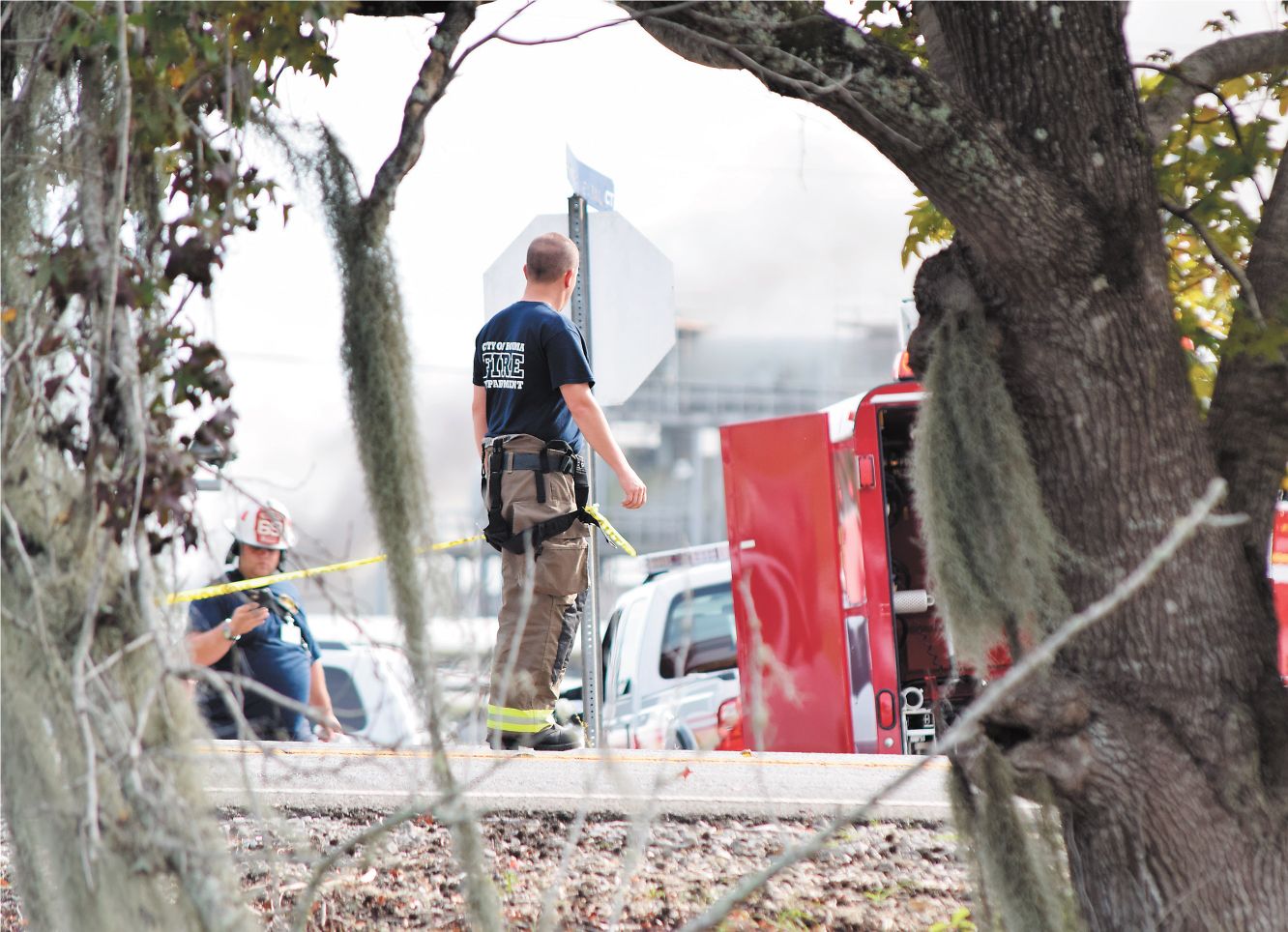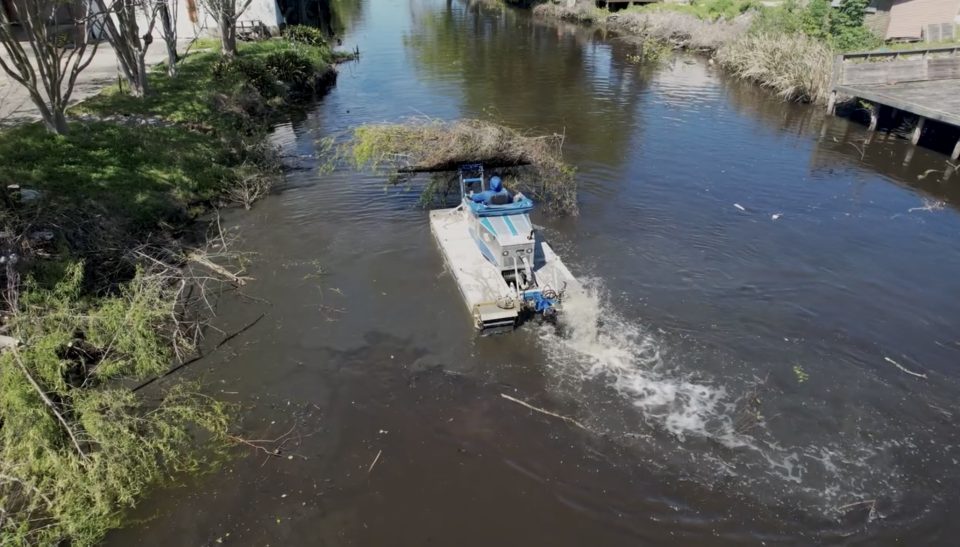
Behind Closed Doors: Recordings, interviews show HPD chief’s retirement was forced
October 14, 2015
Chatman honored by peers
October 20, 2015Terrebonne Parish first-responders say planning and coordination were key elements of their efforts to cope with a fire and explosion at a Gibson gas pipeline station last Thursday that claimed the lives of three workers and injured two others.
Federal investigators, meanwhile, continue their search for clues to what caused the incident at the Williams Pipeline Company, 4711 Bayou Black Drive.
“The facility remains shut down and a cause of the incident has not been determined at this time,” said Damon Hill, a spokesman for the U.S. Department of Transportation’s Pipeline and Hazardous Materials Safety Administration. PHMSA and the U.S. Occupational Safety and Health Administration are among the agencies actively involved with the case.
Two of the fatalities, Casey Ordoyne, 36, of Larose, and Samuel Brinlee, 40, of Berwick, were employees of Danos, an oilfield specialty personnel and equipment company under contract to Williams. Another contractor, Geismar-based Furmanite, also lost an employee to the blast, but has not yet made the worker’s identity public.
According to information supplied by Williams and various agencies, the workers were doing what was described as “routine” maintenance work on a portion of the Gibson operation called a “slug-catcher” when the incident occurred.
A slug-catcher is a series of pipes or a tank that hold moist and sometimes volatile components filtered out of natural gas as it travels from the place where it is drilled to a main pipeline.
The slug-catching apparatus at Williams is described as a “finger” style, meaning it is composed of a series of primarily horizontal pipes, and primarily near ground level.
Thursday’s incident occurred during the scheduled maintenance shutdown of a vital supply link from the Gulf of Mexico to the 10,000 mile Transcontinental Pipeline that supplies natural gas from its source wells all the way to New York., which began Oct. 4. Therefore there was no gas flowing through the system when the blast occurred.
“We were supposed to come back online Oct. 12,” said Chirstopher Stockton, a Williams spokesman.
The Gibson plant is used for compression, the elimination of moisture and other impurities from the product, which must travel dry in the main pipeline. The compressor itself was not damaged, Stockton said.
A Times examination of federal records indicated no reported deficiencies at the plant. Stockton confirmed that in his experience, incidents involving the slug-catching systems are rare.
But for firefighters in the Gibson area – and emergency preparedness supervisors who head up a parish-wide disaster response team – the Williams facility and its layout was anything but an unknown.
Two firefighting entities, the Bayou Black and the West Terrebonne fire departments, were called out to the blast simultaneously when it was reported at 11 a.m.
“That type of response to the plant is pretty much automatic to begin with,” said West Terrebonne Chief Johnny Bush, who had equipment rolling from all of his three stations, including a foam truck and a heavy rescue unit.
The Bayou Black department, commanded by Chief Tony Bersegay, simultaneously dispatched trucks, including its own heavy rescue unit.
Bersegay, a Williams employee, was not at work when the incident occurred. But his familiarity with the plant, coupled with prior drills for both departments, is credited with a quick setup and establishment of a command post immediately upon arrival.
As part of the rapid-response plan Acadian Ambulance dispatched two of its Air-Med helicopters as well as ground ambulances and mobile supervisors.
Without knowing initially what had caused the explosion and resulting fire, as well as what materials may have been involved, officials set about the simultaneous task of dealing with the incident itself as well as determining what notifications should be made to residents, and how to keep them safe.
Coordination of life-saving efforts was aided by mobilization of the Parish Rapid Assessment Team, an arm of the Terrebonne Office of Homeland Security and Emergency Preparedness, under the command of its director, Earl Eues.
Thomas Long, the PRAT’s hazardous materials responder and its chief coordinator, was paying a visit to the West Terrebonne station when the incident occurred.
“As soon as they were paged out, they rolled out their fire truck and I rolled right behind them,” Long said.
The 30-member PRAT team is made up of deputies from the Terrebonne Parish Sheriff’s Office, Houma Police Department officers, and members of fire districts and companies throughout the parish, each versed in areas of expertise that can aid disaster response.
Fourteen PRAT members responded.
Long’s first task upon arrival was determining the chain of command at the site, as determined by the fire chiefs and their pre-plan.
“The main thing is once you get on scene with something like that, is find out who’s in charge. Find out what’s going on and who’s in charge,” Long said.
Fire suppression and a search for victims was commenced, as black smoke billowed from the twisted wreckage of the pipe network. Because hazardous materials were involved, the PRAT’s decontamination set-up helped keep first-responders safe.
“We were supporting the fire department so what we were doing was decontamination.,” Pratt said. “So we had decontamination tents set up and we were monitoring the air the entire time.”
Other members checked air-quality meters; the injured were loaded up and sent to the medical centers awaiting them.
“The main thing on a response is life saving,” said Eues. “That is the main issue, to not cause other people to get injured or get injured themselves. So that is the goal, when those guys respond, is to know what the issue is, know what the chemical is, know what the incident is, know what the area’s like.”
Long said PRAT members were release from the scene as the needs for their individual skills abated.
Its last remaining members left around 1 a.m. on Friday, according to Long, who said that if relief for PRAT personnel was needed, emergency workers with PRAT training from other parishes could have been called.
Eueus said that the explosion on Thursday was the largest industrial incident he has seen in his eight years heading TOHSEP. Both Eueus and Long said that they were very pleased with their office’s response to the Gibson explosion. Eues credited Long with the best outcome that could be expected of such a tragedy, that no additional lives were lost.
“Tom’s done a great job in getting that team up to training and staffed with personnel,” Eues said. “When we have one of these incidents, we know that they can handle it.”
Like the fire departments, the PRAT members had also worked on pre-plans for the Williams site.
“In fact we had met with Williams about a year ago, it may have been 18 months ago, to work on that facility and initiate some planning on that facility,” Eues said.”So we were kind of familiar with the facility and knew some of the people that were there.” All of Terrebonne’s 13 fire departments provided manpower and equipment in varying degrees.
The professionalism exhibited by firefighters, Eues said, was a major positive component of the operation.
“I’ve got to commend the fire departments for the job they did yesterday, cause this isn’t something they do all the time,” he said. “Industrial incidents are not something they respond to very often, and they did a great job.”












